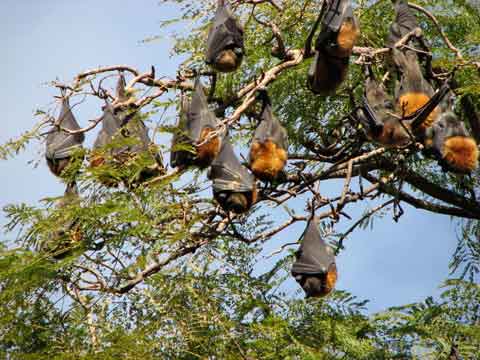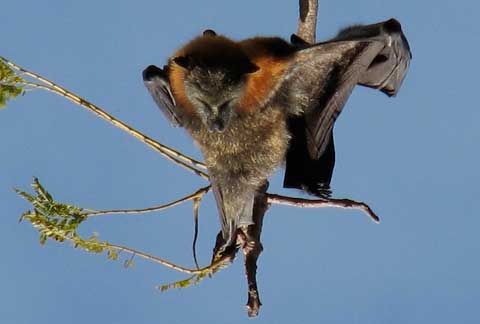 If you became homeless because your house was being demolished, obviously you’d have to find a new home to live in. It’s no different for other animals; we all need shelter, a home, habitat.
If you became homeless because your house was being demolished, obviously you’d have to find a new home to live in. It’s no different for other animals; we all need shelter, a home, habitat.
However, I suppose we wouldn’t be allowed to choose the amenities block or the bandstand in a public park, let alone bring all our relatives. Similarly, there is much ado when a whole colony of wild creatures takes up residence in civic gardens or parks. Grey-headed Flying-foxes are a common ‘nuisance’ in many town and city parks as land clearing proceeds for development such as mining or housing, and their natural habitat is disturbed or lost. Communities are then divided with debates about how to make them move on before they defoliate all the long-established and cherished trees in a park like this one.
Sydney’s Botanic Gardens has the same problem. Bat droppings, bat screechings and bare trees are not the most inviting ambience for picnickers, walkers — or Anzac Day ceremonies.

But they are merely the victims, like many of us, of shortsighted ‘planning’. In fact, these Grey-headed Flying-foxes (sometimes called Grey-headed Fruit-bats) are listed as a vulnerable species.
I took the chance to observe them at a stop at this park. After all, it’s pretty amazing that bats are the only mammals capable of sustained flight.
They spend the day in large camps and head out to feed at night, using sight and smell to find their preferred foods, the blossom and nectar of eucalypts and native fruits and lillipillies.
From introduced trees like jacarandas and firs they were hanging like thousands of leather lanterns with bright furry tops — each upside-down, and by the claws of one forelimb, daredevil style.
They can see quite well in daytime so that must be why they tuck their heads in. Many seem to have trouble getting comfy – they screeched and chattered and wriggled, stretched and flapped their amazing wings, which can exceed a metre in span, before rewrapping themselves in their slinky Batman blankets.

These Flying-foxes, with their foxfire collars, do have faces like foxes, or dogs, as the reversed photo of this restless one shows. They are not at all ugly, and certainly fascinating.
I don’t think I’d want them as close neighbours, but then I’m increasing rather than reducing habitat here, so there’d be room for us all.
Hi Dariam,
Know the area a bit; stayed at the Buddhist monastery once. I think MT Kembla is inland from there? Do let us know what you think of the book.
Sharyn
Hi Darian,
Is this south of Sydney or? We do a great job of making life even harder than nature can does for such creatures, don’t we?
Thanks for the input.
Flying Foxes suddenly turned up here this Autumn to feed on the privet berries which are in abundance on old homeblock sites. Since they are being ousted from the Botanical Gardens, I assumed they were making their way down the coast to find new digs. As it turns out, storms earlier this year washed a lot of pollen and nectar from their preferred trees and so they are on the hunt for food in new areas that they don’t usually habituate. Apparently several specimens, some pregnant, have been found to be underweight, Already vulnerable, things aren’t looking so good for the Grey-Headed Flying Fox right now.
Hi Peter,
Yes, it’s Burdekin Park in Singleton, on the New England Highway. And that was an interesting newsletter, thanks for the link.
Hi Sharyn,
Is that Singleton?
A nice report about bats in the August 2010 Wollombi Valley Landcare Newsletter – http://wollombi.nsw.au/landcare/
Great shots, especially the last one. They really are very pretty and interesting faces. I love the little ones I get here.
P
Yes Denis, thousands might be a bit less fascinating!
Hi Sharyn
Careful what you wish for, with Flying Foxes.
Plenty of room, could soon run out, if mobs of them arrived.
I agree they are fascinating, remarkable creatures.
They are also important pollinators of many rain forest trees.
Nice images.
Denis